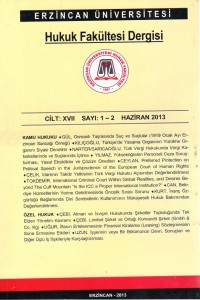Abstract
References
- Muller v. Switzerland, (App. 10737/84), 24 May 1988, Series A No 133, (1991) 13 EHRR 212.
- Handyside v United Kingdom, (App. 5493/72), 7 December 1976, Series A No 24, (1979-80) 1 EHRR 737.
- Leroy v France, (App. 36109/03), 2 October 2008.
- Otto-Preminger Institute v Australia, (App. 13470/87), 20 September 1994, Series A No 295-A, (1994) 19 EHRR 34.
Abstract
The right to freedom of expression which is provided in the European Convention on Human Rights Article 10 is extremely broad. All types of expression are covered in the first paragraph of Article 10 such as paintings1, books2, cartoons3, films4, vide-recordings. There are mainly four types of expression covered by the Strasburg Court in its case law. These are political expression, religious or moral expression, commercial expression and artistic expression. It is explicitly recognised about the protection of free expression in the text of article 10 and also by the Court in its jurisprudence that free expression is a powerful tool carrying special responsibilities and duties particularly free speech on public debates and mass media. Free speech has a power to promote democracy and also advanced scientific, political, commercial and artistic development. For that reason, it is claimed that to protect the right to free speech is vital in itself. The Court is also aware of that freedom of speech and expression can be used to impinge on individual privacy and also to incite violence of basic rules. As a result, the Strasburg Court’s case law is an attempt to make a proper balance between these competing interests.
References
- Muller v. Switzerland, (App. 10737/84), 24 May 1988, Series A No 133, (1991) 13 EHRR 212.
- Handyside v United Kingdom, (App. 5493/72), 7 December 1976, Series A No 24, (1979-80) 1 EHRR 737.
- Leroy v France, (App. 36109/03), 2 October 2008.
- Otto-Preminger Institute v Australia, (App. 13470/87), 20 September 1994, Series A No 295-A, (1994) 19 EHRR 34.
Details
| Primary Language | English |
|---|---|
| Subjects | Law in Context |
| Journal Section | Research Articles |
| Authors | |
| Publication Date | June 1, 2013 |
| Submission Date | November 1, 2013 |
| Published in Issue | Year 2013 Volume: XVII Issue: 1-2 |


